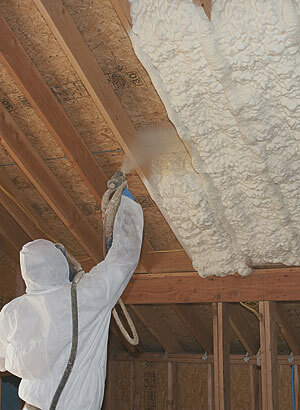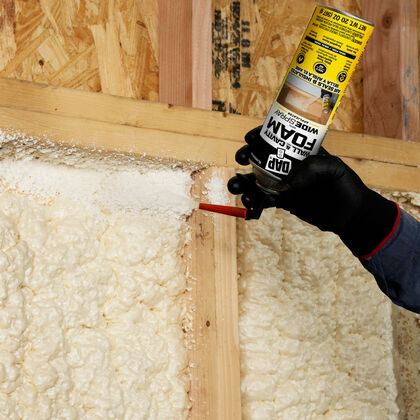The Environmental Impact of Spray Foam: Sustainability Considerations
The Environmental Impact of Spray Foam: Sustainability Considerations
Blog Article
Spray Foam: The Ultimate Option for Air Sealing and Insulation
Spray foam insulation has emerged as a leading solution for efficient air securing and thermal insulation, providing a special mix of residential or commercial properties that set it apart from traditional approaches. Recognizing the full range of its benefits, installment procedures, and comparisons with other insulation types is crucial for making educated choices.
What Is Spray Foam?
Spray foam is a flexible insulation material that combines the concepts of air securing and thermal resistance to enhance energy performance in buildings. Composed largely of polyurethane or various other similar substances, spray foam is applied as a liquid that increases upon contact with surface areas, producing a solid, continual layer of insulation. This one-of-a-kind building enables it to fill voids, fractures, and voids that typical insulation products may overlook, giving a remarkable air seal.
There are two major kinds of spray foam: open-cell and closed-cell. Open-cell spray foam is lighter and more flexible, providing exceptional sound absorption and a reduced R-value per inch - Spray Foam. In contrast, closed-cell spray foam is denser, supplying a higher R-value, dampness resistance, and included structural stability to building elements
The application procedure normally involves specialized tools, guaranteeing a smooth application that follows different substratums, including concrete, metal, and wood. This adaptability makes spray foam appropriate for both brand-new constructions and retrofitting existing frameworks. Its capacity to develop an airtight obstacle dramatically adds to minimizing energy usage and improving indoor air high quality, consequently making it a recommended choice among home owners and builders alike.
Benefits of Spray Foam Insulation
Among one of the most substantial advantages of spray foam insulation is its outstanding capacity to create a constant air obstacle, which properly minimizes energy loss. Unlike standard insulation products, spray foam expands to fill splits and voids, guaranteeing that air leakage is drastically decreased. This particular not just boosts power efficiency but also results in reduce energy costs over time.
Additionally, spray foam insulation offers remarkable thermal resistance, adding to a much more stable interior setting. Its high R-value per inch enables efficient insulation in confined spaces, making it ideal for attic rooms, wall surfaces, and crawl rooms. The moisture-resistant buildings of spray foam aid protect against mold and mildew development, advertising healthier living problems.
Another critical advantage of spray foam insulation is its sound-dampening high qualities (Spray Foam). It effectively lowers noise transmission in between spaces, producing a quieter and much more comfortable home setting. The longevity of spray foam additionally sticks out, as it does not sag or resolve with time, keeping its performance throughout its lifespan
Just How Spray Foam Works
Understanding just how spray foam insulation functions is necessary for appreciating its performance in air sealing and thermal resistance. Spray foam insulation contains 2 main components: isocyanate and polyol resin. When these parts are blended, they undergo a chain reaction that triggers the material to expand rapidly, creating a thick foam that fills up fractures, voids, and tooth cavities.
As the foam broadens, it follows surface areas, forming a closed seal that dramatically reduces air infiltration. This characteristic makes spray foam insulation extremely reliable at avoiding drafts and wetness infiltration, which can cause power loss and damages over time. Additionally, the closed-cell variation of spray foam uses superior thermal resistance due to its stiff structure, properly decreasing heat transfer.
The distinct residential or commercial properties of spray foam enable it to adapt to uneven surface areas, ensuring extensive insurance coverage and a seamless barrier. Therefore, spray foam insulation not only improves energy effectiveness but also contributes to boosted interior air quality by minimizing the buildup of allergens and pollutants. Eventually, recognizing the auto mechanics behind spray foam underscores its role as a premium option for insulation and air securing in both commercial and household applications.
Installment Process Review

Before installment, the space needs to be properly cleaned up and prepped, ensuring that surface areas are without dust, particles, and moisture. Due to the fact that contaminants can endanger adhesion and overall efficiency, this action is vital. As soon as the location is prepared, the application involves blending the two parts of the spray foam, which broadens upon contact and fills gaps successfully.
Trained professionals should conduct the installation, using specialized devices to guarantee uniform protection and ideal density. Safety and security safety measures, consisting of using protective equipment and making certain correct air flow, are crucial throughout this process. After application, the foam usually remedies rapidly, forming a strong obstacle that visit site improves energy efficiency.
Comparing Spray Foam to Typical Insulation
When reviewing insulation alternatives, spray foam insulation sticks out in comparison to conventional materials such as fiberglass and cellulose. Among the main advantages of spray foam is its superior air securing abilities. Unlike fiberglass and cellulose, which can allow air seepage, spray foam broadens upon application, filling voids and holes to develop a closed seal. This results in boosted energy efficiency, as much less heated or cooled down air escapes the home, bring about lower utility expenses.
In addition, spray foam supplies a higher R-value per inch than standard insulation types, supplying even more effective thermal resistance in a thinner profile. This particular is especially advantageous in spaces with minimal tooth cavity depth. In addition, spray foam is resistant to moisture and mold and mildew development, which can be a substantial worry with cellulose and fiberglass, especially in moist atmospheres.
Nonetheless, spray foam insulation normally brings a greater upfront price than its standard equivalents. House owners should consider this initial financial investment versus long-term power financial savings and efficiency benefits. Eventually, while both insulation types offer their objective, spray foam emerges as an advanced service for modern-day insulation demands, especially in terms of air sealing and thermal performance.

Final Thought
In summary, spray foam insulation stands for a highly efficient solution for attaining optimal air securing and thermal resistance. Its unique properties, including dampness resistance and sound dampening, make it appropriate for numerous applications in both new constructions and retrofitting projects (Spray Foam). Although the preliminary costs may be greater compared to typical insulation materials, the long-term benefits, such as significant power financial savings and enhanced indoor air quality, warrant the financial investment and underscore its value in contemporary structure methods.
Spray foam insulation has emerged as a leading service for reliable air sealing and thermal insulation, offering an unique mix of residential or commercial properties that establish this article it apart from typical methods.Spray foam is a functional insulation material that incorporates the principles of air securing and thermal resistance to enhance power effectiveness in structures.When assessing insulation alternatives, spray foam insulation stands out in comparison to typical materials such as fiberglass and cellulose. Inevitably, while both insulation types offer their function, spray foam arises as a more innovative solution for contemporary insulation demands, especially in terms of air securing and thermal efficiency.
In summary, spray foam insulation stands for a highly efficient remedy for accomplishing optimum air sealing and thermal resistance.
Report this page